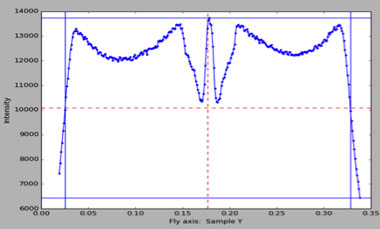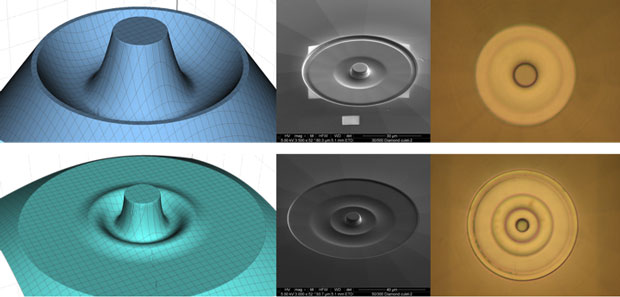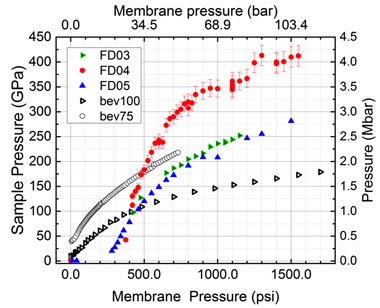Zsolt Jenei (16-FS-010)
Abstract
Our objective was to explore the feasibility of achieving multi-megabar static pressures, exceeding 5 to 6 Mbar, using toroidal surfaces sculpted with focused ion-beams on the tips of diamond anvils for measuring volume as a function of pressure using synchrotron x-ray diffraction techniques. This approach, which would double the current conventional range of static high-pressure experiments, has been demonstrated by a single research group in France (the Alternative Energies and Atomic Energy Commission) and mimics the anvil geometries used in large-volume press systems. High-fidelity pressure, volume, and temperature equation-of-state measurements of materials in diamond anvil cells at these extreme pressures, which exceed that of the Earth‘s core, will access new regimes important to fundamental science and provide data that will guide the development of and validate predictive models. These sculpted toroidal (donut-shape) anvils are a recent development, and Livermore has the opportunity to take the lead in their development by making further improvements to the technology. Building on the Laboratory's expertise, we intended to explore finite-element modeling to identify performance dependencies of the toroidal anvil geometries, including double-toroid structures, and to use oxygen-plasma etching to treat the anvil surface and “heal” microscopic cracks that can initiate premature anvil failure. We were able to explore the feasibility of achieving multi-megabar static pressures, exceeding the current limits of diamond anvil cells, using toroidal surfaces sculpted with focused ion beams on the tips of diamond anvils. We demonstrated that the toroidal diamond anvils are capable of producing static high pressures beyond the pressures expected of the starting anvils. We reached 420 GPa with a single torus design, which will be a strong foundation for continued study and further development.
Background and Research Objectives
In the development of accurate high-pressure and temperature equations of state, some of the most important experimental constraints are the pressure–volume curves. Diamond anvil cells are an excellent tool for measuring volume as a function of pressure with high accuracy along a well-defined isotherm using synchrotron x-ray diffraction techniques. Diamond anvil cells with beveled diamonds and flat sizes of 20 to 30 µm are capable of generating pressures beyond 300 GPa. Nevertheless, attaining pressures close to 400 GPa is extremely challenging and rarely achieved. Significantly higher pressures can be reached by various dynamic compression methods, such as gas-gun-driven shock compression and, with the advent of high-powered lasers, by laser compression, either laser-driven shock compression or ramp compression. In recent years, successful attempts have been made to extend the pressure limit of the diamond anvil cells. Researchers from the University of Bayreuth (Germany) employed a two-stage diamond anvil cell to reach pressures in excess of 640 GPa1 and later 750 GPa.2 This approach achieved impressive results, but it has a success rate of less than 5% because it requires precise alignment of 10- to 15-µm diameter nanocrystalline diamond hemispheres within a conventional diamond anvil cell, as well as additional design constraints.
The most recent approach to advance beyond the pressure limit imposed by conventional diamond anvils is by micro-fabricating toroidal surfaces at the tip of the diamond anvils. Researchers at the Alternative Energies and Atomic Energy Commission in France have fabricated diamond anvils with toroidal geometry that show significant performance enhancement and potential for further advances.3,4
Considering the experimental infrastructure in place, we opted to study the feasibility of attaining pressures beyond the conventional diamond anvil cell limits by modifying the culet (tip compressing the sample) surfaces of conventional diamond anvils. With this approach, in a short amount of time, we were able to show that it is feasible to achieve pressures over 400 GPa with diamond anvils, and worked on further extending the pressure range and improving the success rate of the experiments. Figure 1 shows the compression curves of some of the test anvils.
Figure 1. Sample pressure as a function of loading membrane pressure for test diamond anvil cells. The open black symbols represent typical compression curves for traditional diamond anvils. Solid symbols are from three select diamond pairs we machined.
Scientific Approach and Accomplishments
Anvils sculpted with focused ion beams are a very recent development. The only reports of this work are in proposals and a single conference presentation by the Alternative Energies and Atomic Energy Commission researchers. Most importantly, the precise details such as the culet and torus parameters are largely unknown. We started with the goal of machining a toroidal surface onto the tip of the diamond anvil. A generic sketch of a toroidal surface is shown in Figure 2. On this cross section of the diamond we show the most important parameters of the toroidal surface: the depth of the torus, the distance of the deepest section relative to the edge of the culet, and the diameter of the new culet. Besides these, obviously the relative height of the edge to the culet is not negligible. To put the concept in practice, we generated a numerical, three-dimensional model of the diamond surface that we subtracted from the starting diamond anvil model and used a focused ion beam to remove the difference. We paired up the resulting anvils in standard Livermore-design membrane diamond anvil cells for testing. Because rhenium proved to be the optimal choice of metallic gasket used by the static high-pressure-physics community, we used it as the testing gasket.
The primary goals of the changes to the diamonds were to decrease the area of the culets and alleviate the stress that leads to fracture of the diamonds. As starting anvils, we chose single-beveled diamond anvils manufactured by Almax with culet sizes 30 to 50 μm on a 300-μm bevel, and a facet angle of 8.5°. To achieve higher pressure, we need to have a smaller culet and use the toroidal feature to prevent the outflow of the gasket material.
Testing experiments of the designs consisted of compressing gold in a rhenium gasket and collecting angular dispersive x-ray diffraction patterns during compression. The diamond anvil cells were prepared with diamond anvils with identical toroidal tips sculpted with focused ion beams. The experiments were carried out at the Advanced Photon Source at Argonne National Laboratory. We used angular dispersive x-ray diffraction at the 16 insertion device beamline with a microfocused beam of 1- × 2-μm full-width-at-half-maximum dimensions. We collected angular dispersive x-ray diffraction patterns on the center of the culet and additionally at important pressure points, mapping the pressure gradients in the whole culet area in two dimensions with a resolution of 1 μm to map. The pressure has been determined by using the equation of state of gold and rhenium.1
We experimented with two basic designs: a single torus and a double torus model with culet sizes ranging from 15 down to 9 μm, and depth of torus varying from 2 to 4.5 μm. Given the limited amount of time and the challenging nature of experiments, we were not able to pursue post-milling treatment of the machined surfaces. It is known that ion milling of the diamond surface introduces damages in the top layer of the single-crystal diamonds, and that this can be reversed by heat treatment.5 As shown in the scanning electron microscopy images of the milled diamonds (middle column in Figure 3), the transition from milled area to the untouched area is still not very smooth, and there is a ring with high-stress concentration on the surface of the diamond. As shown in Figure 4, a typical x-ray transmission profile of the gasket-sample assembly in the diamond anvil cell, the center portion of the transmission curve represents the thinnest portion of the gasket. This is where the pressure (in this particular case) is about 400 GPa. The other regions where the gasket is thinner is the edge of the 300-μm base section and at the aforementioned edge of the milled area. We were able to solve this edge issue for the last pair of diamonds prepared. However, testing of these diamonds was not possible before the end of the feasibility study.
Figure 4. X-ray transmission across the center line of the diamond anvil. Higher-transmitted intensity indicates that the gasket is thinner between the diamonds.
Impact on Mission
This study supports the Laboratory's stockpile stewardship mission and the high-energy-density-science core competency by advancing Livermore's capabilities to the leading edge of static high-pressure science. It opened the way to provide validated tools for measuring fundamental properties of scientifically and programmatically important materials. Demonstrating the feasibility of this capability has led to a project to expand the platform for investigations of scientific and technological materials in entirely new regimes of extreme conditions, and enabled the hire of at least one postdoctoral researcher to train the next generation of scientists.
Conclusion
We showed that it is feasible to achieve static high pressures beyond the limits of conventional diamond anvil cells by reaching 420 GPa with a diamond that, without the toroidal treatment, is typically capable of 300- to 325-GPa pressure. The results of this investigation have formed the basis of a new project that aims to study ultrahigh-pressure and high-temperature phase transitions in metal and expand the technical capability of anvils crafted with focused ion beams.
References
- Dubrovinsky, L., V. B. Prakapenka, and A. M. Abakumov, "Implementation of micro-ball nanodiamond anvils for high pressure studies above 6 Mbar." Nat. Comm. 3, 1163 (2012).
- Dubrovinsky, L., et al., "The most incompressible metal osmium at static pressures above 750 gigapascals." Nature 525, 226 (2015).
- Dewaele, A., P. Loubeyre, and F. Occelli, "New diamond anvils to perform measurements up to 0.5 TPa: Validation of Ta behavior," ESRF Experiment Report. Alternative Energies and Atomic Energy Commission, Grenoble, France (2014).
- Dewaele, A., F. Occelli, and P. Loubeyre, "New diamond anvils to perform experiments up to 500 GPa (continuation)," ESRF Experimental Report. Alternative Energies and Atomic Energy Commission, Grenoble, France (2015).
- Kawasegi, N., et al., "Single-crystal diamond tools formed using a focused ion beam: Tool life enhancement via heat treatment." Diam. Relat. Mater. 49, 14 (2014)









